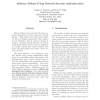197 search results - page 6 / 40 » Is attack better than defense |
HICSS
2006
IEEE
14 years 1 months ago
2006
IEEE
Honeypots are computer systems that try to fool cyberattackers into thinking they are ordinary computer systems, when in fact they are designed solely to collect data about attack...
SIGOPSE
2004
ACM
14 years 27 days ago
2004
ACM
Overlay networks are widely used to deploy functionality at edge nodes without changing network routers. Each node in an overlay network maintains pointers to a set of neighbor no...
ACSAC
2007
IEEE
14 years 1 months ago
2007
IEEE
We exploit for defensive purposes the concept of darkports – the unused ports on active systems. We are particularly interested in such ports which transition to become active (...
NSDI
2008
13 years 9 months ago
2008
Hidden malicious circuits provide an attacker with a stealthy attack vector. As they occupy a layer below the entire software stack, malicious circuits can bypass traditional defe...
IWIA
2005
IEEE
14 years 1 months ago
2005
IEEE
Malware defenses have primarily relied upon intrusion fingerprints to detect suspicious network behavior. While effective for discovering computers that are already compromised,...


